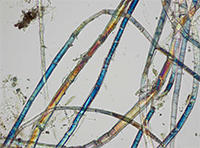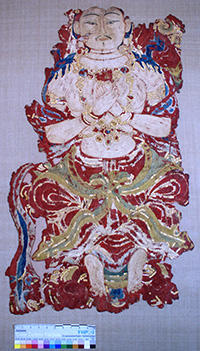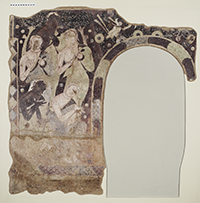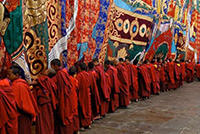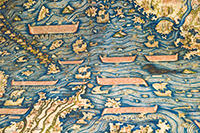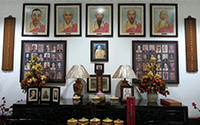2021 Past Event Calendar
The Narrative of the Buddha’s Life in Gandharan Art Between Storytelling and Performance
Lecture: Center for Buddhist Studies: Tang Center for Silk Road Studies | February 19 | 2-4 p.m. | Online Zoom Webinar
Speaker: Pia Brancaccio, Professor of Art History, Drexel University
Sponsors: Tang Center for Silk Road Studies, Center for Buddhist Studies, Institute for South Asia Studies
In the Kushan period (1st- 3rd c. CE) Gandharan artists created a large body of narrative sculpture depicting the Buddha’s life story in a chronological and sequential manner. The Buddha’s actions in these pictorial narratives display a dramatic and cohesive thread that has no precedents in Indian art. The lecture intends to explore how this radically new way of narrating the Buddha’s life in Gandharan art may have been informed by modes of representations established in theatre. Textual and visual evidence speak for the early development of Sanskrit theatre and Buddhist drama in the Northwest of the Indian Subcontinent in the first centuries CE. Recent archaeological discoveries from Swat, Pakistan show how images associated with western theatrical performances were seamlessly integrated within the decoration of Buddhist stupas. All of the above evidence suggests that the performative tradition may have played a key role in the process of formulation and codification of Buddhist narrative art in the region.
Speaker: Pia Brancaccio is a Professor of Art History at Drexel University. Her research focuses on Buddhist art from South Asia, where she has traveled extensively. Her most recent publications include a monograph entitled The Buddhist Caves at Aurangabad: Transformations in Art and Religion (Brill, 2010) and edited volumes entitled Living Rock: Buddhist, Hindu and Jain Cave Temples in Western Deccan (Marg, 2013) and Gandharan Buddhism: Archaeology, Art and Text with K. Behrendt (UBC Press 2006).
Gandharan Buddhist Reliquaries and Gandharan Buddhism
Lecture: Tang Center for Silk Road Studies | March 12 | 2-4 p.m. | Online Zoom Webinar
Speaker: Richard Salomon, Emeritus Professor of Asian Languages and Literature and William P. and Ruth Gerberding University Professor Emeritus, University of Washington
Sponsors: Tang Center for Silk Road Studies, Center for Buddhist Studies
Speaker: Richard Salomon (PhD, University of Pennsylvania, 1975) is Emeritus Professor of Asian Languages and Literature and William P. and Ruth Gerberding University Professor Emeritus at the University of Washington. He is the former president of the International Association of Buddhist Studies and of the American Oriental Society, and since 1996 the director of the University of Washington’s Early Buddhist Manuscripts Project.
Professor Salomon’s specialties include Sanskrit language and literature, Indian Buddhist literature and textual studies, Indian epigraphy and paleography, Gāndhārī language and Gandhāran studies, and the world history of writing. He has published seven books and over 150 articles in these and other fields, including Indian Epigraphy (1998), Ancient Buddhist Scrolls from Gandhāra (1999), Two Gāndhārī Manuscripts of the “Songs of Lake Anavatapta” (2008), and Buddhist Literature from Ancient Gandhāra (2018).
Where was wine drunk in Gandhara? New Insights into Reveling Scenes in the light of a Stylistic Analysis
Lecture: Tang Center for Silk Road Studies | April 16 | 12-2 p.m. | Online Zoom Webinar
Speaker: Jessie Pons, Junior Professor South Asian History of Religion, Center for Religious Studies (CERES) CERES, Ruhr Universität Bochum
Sponsors: Tang Center for Silk Road Studies, Center for Buddhist Studies
This presentation will outline some of the results of research on the identification and characterization of Gandharan sculptural styles and highlight how a traditional stylistic analysis can contribute to broader questions about Gandharan art, from the provenance of the artefacts to the signification of the scenes they represent. As a preamble, it will present the methodological approach underlying the stylistic study and sketch a map of the sculptural languages circumscribed across Gandhara. It will subsequently examine a case-study – the depiction of reveling scenes – and illustrate how an emphasis on patterns of geographic distribution may add to the discussion on phenomena of cultural and religion interaction in the region. It will further show how attention to formal and iconographic variations can – perhaps predictably – inform us on the provenance of pieces found outside of archaeological contexts and thereby invite to reflect on the methodological frameworks within which we approach these variations.
Speaker: Jessie Pons studied art history, Indian studies, and museum studies at the School of Oriental and African Studies, École du Louvre, and the University of Paris from which she earned her Ph.D. in 2011 with a thesis on Gandharan Buddhist art. Since 2010, she has been affiliated with the Centre for Religious Studies in Ruhr Universität Bochum and was appointed Junior-Professor for South Asian History of Religions in 2016. Her research focuses on the interplay between material objects, textual traditions and religious experiences and she has been involved in several projects for the digital documentation and preservation of Buddhist artefacts.
Prophecy in Time and Place: Reading “The Prophecy of the Arhat of Khotan” as a Ring Composition
Colloquium: Tang Center for Silk Road Studies | May 5 | 12-2 p.m. | Online Zoom Webinar
Speaker: Meghan Howard, Ph.D. Candidate, Group in Buddhist Studies, UC Berkeley
Sponsor: Tang Center for Silk Road Studies
“The Prophecy of the Arhat of Khotan” presents a prophecy of the demise of the Dharma in Central Asia, following the fortunes of a group of monks who are exiled from a series of Central Asian states, Tibet, and Gandhāra before finally slaughtering each other in Kauśāmbī. One of the well-known set of Tibetan texts on Khotan, “The Prophecy” has been studied by scholars for well over a century. Yet existing studies have largely mined these sources for Khotanese and Tibetan historical data. In this presentation, I ask, What can we learn when we approach the text on its own terms? Analyzing the literary structure of “The Prophecy” reveals the clarity and coherence of what can otherwise appear to be an unwieldy narrative. And by considering this structure within the historical context that produced it, I am able to shed light on the narrative’s rhetorical import with implications for our understanding of ninth-century Tibetan and Khotanese history. By demonstrating the interpretative power—including for data-mining projects—of simply reading Silk Road texts as products of a specific time and place, this presentation encourages scholars to expand and re-center our approach to the Tibetan texts on Khotan and to Dunhuang materials in general.
Speaker: Meghan Howard holds a B.A. in Tibetan and Himalayan Studies from Harvard University (2004). Her work as a Tibetan translator and interpreter led her to Songtsen Library in Dehradun, India, where she spent four years working on a translation project involving Dunhuang materials related to the history of Tibet's imperial period (7th to 9th centuries). Her research interests center on cultural and religious exchanges between Tibet and neighboring peoples from the imperial period through the fourteenth century. She is currently writing a dissertation on Facheng 法成/Chödrup (Chos grub, d. c. 860), an influential Buddhist monk and translator of Buddhist scriptures from Chinese to Tibetan and vice versa in the important Silk Road oasis of Dunhuang.
A lost Buddhist sect at Dunhuang—the Three Levels Movement in the Dunhuang Documents
Colloquium: Tang Center for Silk Road Studies | May 12 | 2-4 p.m. | Online Zoom Webinar
Speaker/Performer: Max Brandstadt, Ph.D. Candidate, Group in Buddhist Studies, UC Berkeley
Sponsor: Tang Center for Silk Road Studies
The Dunhuang documents, discovered in the early 1900s at the Mogao cave complex on the Chinese outskirts of the Silk Road, revolutionized our understanding of the development of Buddhism in China. One of the many surprises contained in the Dunhuang manuscript cache was the discovery of a substantial number of texts by the so-called ‘Three Levels Movement,’ a mysterious Buddhist sect that flourished during the sixth and seventh centuries of the common era, and then vanished. This talk will provide a sketch of this oft-misunderstood group—their practices, institutions, and beliefs—through the lens of relevant manuscripts preserved at Dunhuang.
Speaker: Max Brandstadt is a Ph.D. candidate in the Group in Buddhist Studies at UC Berkeley, specializing in the history of medieval Chinese Buddhism. He is currently writing his dissertation on the development of the Three Levels Movement and its influence on later Chan and Pure Land Buddhism. He will be a Junior Fellow in the Harvard Society of Fellows beginning Fall 2021.


